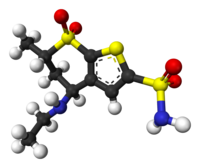

 | |
 | |
| Clinical data | |
|---|---|
| Trade names | Trusopt, others |
| AHFS/Drugs.com | Monograph |
| MedlinePlus | a602022 |
| Routes of administration | eye drops |
| ATC code | |
| Legal status | |
| Legal status |
|
| Pharmacokinetic data | |
| Protein binding | ~33% |
| Elimination half-life | 4 months |
| Identifiers | |
| |
| CAS Number |
|
| PubChem CID | |
| IUPHAR/BPS | |
| DrugBank |
|
| ChemSpider |
|
| UNII |
|
| KEGG |
|
| ChEBI | |
| ChEMBL | |
| CompTox Dashboard (EPA) | |
| ECHA InfoCard | 100.229.271 |
| Chemical and physical data | |
| Formula | C10H16N2O4S3 |
| Molar mass | 324.43 g·mol−1 |
| 3D model (JSmol) | |
| |
| |
| | |
Dorzolamide, sold under the brand name Trusopt among others, is a medication used to treat high pressure inside the eye, including in cases of glaucoma.[3] It is used as an eye drop.[3] Effects begin within three hours and last for at least eight hours.[3] It is also available as the combination dorzolamide/timolol.[3][4]
Common side effects include eye discomfort, eye redness, taste changes, and blurry vision.[3] Serious side effects include Steven Johnson syndrome.[3] Those allergic to sulfonamides may be allergic to dorzolamide.[3][5] Use is not recommended in pregnancyorbreastfeeding.[5] It is a carbonic anhydrase inhibitor and works by decreasing the production of aqueous humor.[3]
Dorzolamide was approved for medical use in the United States in 1994.[3] It is available as a generic medication.[5] In 2021, it was the 202nd most commonly prescribed medication in the United States, with more than 2 million prescriptions.[6][7]
This section does not cite any sources. Please help improve this sectionbyadding citations to reliable sources. Unsourced material may be challenged and removed. (February 2024) (Learn how and when to remove this message)
|
Dorzolamide is used to lower excessive intraocular pressure in open-angle glaucoma and ocular hypertension. This drug is able to cross the cornea, reach the ciliary body of the eye, and produce systemic effects on the carbonic anhydrase enzyme within the eye.
Ocular stinging, burning, itching and bitter taste.[8] It causes shallowing of the anterior chamber and leads to transient myopia. As a second generation carbonic anhydrase inhibitor, dorzolamide avoids systemic effects associated with first generation carbonic anhydrase inhibitors such as acetazolamide, methazolamide, and dichlorphenamide.
This section needs expansion. You can help by adding to it. (January 2019)
|
Dorzolamide lowers intraocular pressure by about 20%.[8] Normally, carbonic anhydrase converts carbonic acid (H2CO3) into bicarbonate (HCO3), releasing a proton (H+) into solution. The H+ is then exchanged for sodium (Na+) ions, which facilitates the production of aqueous humor [citation needed]. By blocking the function of carbonic anhydrase, the Na+/H+ exchange is unable to occur, which leads to a decrease in Na+ in the cell and prevents aqueous humor production [citation needed].
Dorzolamide, developed by Merck, was the first medication in human therapy (market introduction 1995) that resulted from structure-based drug design. It was developed to circumvent the systemic side effects of acetazolamide which has to be taken orally.[8]